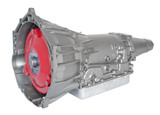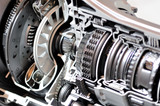Transfixed
Substituting computer for cable
One of the most common components in a contemporary street rod is an overdrive automatic transmission, and one of the most popular of the breed is the General Motors 700-R4. Although the 700-R4 is a good transmission, and can be modified to withstand huge amounts of horsepower, reliability is sometimes and issue, but it’s often not the transmission’s fault.
Although it seems strange, many 700-R4 failures are the result of the carburetor in use; let us explain. All automatic transmissions use hydraulic pressure to apply friction components, either bands or clutches, to shift into each gear. The 700-R4 (as well as the 200-4R and the 4L60) uses a cable (called the throttle valve, or TV cable) connected to the throttle linkage to establish that pressure. White the stock GM induction components (carburetors or fuel injection) have the correct levers, those on many aftermarket carburetors don’t have the proper geometry. As a result, shifting can be erratic and at part-throttle, the hydraulic pressure may be low enough so the transmission will slip, which results in overheating that can cause severe damage and ultimately complete failure.
As production cars have become more sophisticated, it’s no surprise that the latest transmissions don’t use a TV cable and are now computer-controlled. And it’s also no surprise that the same level of sophistication has come to street rods. Electronically controlled transmissions, such as the 4L60E and the 4L65E, can easily be adapted to street rods with the use of a standalone computer. But while these transmissions benefit from modern electronic technology, they can still benefit from some old-fashion, hands-on hopping up.
While the current crop of electronic overdrive automatics don’t have the issues associated with TV cables, they also have a reputation for not being able to handle lots of horsepower. But according to Zack Farah of Gear Star Transmissions, that shortcoming can be resolved.
The process of strengthening these transmission starts with disassembly and a complete cleaning and inspection of the case and any of the parts that will be reused. But where the increase in strength comes from can be found in the long list of special parts Gear Star installs. To understand why some of them are necessary, a basic understanding of transmission operation may be helpful.
Automatics use planetary gear sets to establish the ratios for each shift. Planetary gears are unique in that they can provide forward or reverse, a gear reduction, direct drive, or overdrive; all that changes is which element is the input, which the output, and which is held stationary. With multiple planetary gear sets (which most transmissions have), a variety of gear ratios are available. If nothing is held stationary, no power is transmitted – that’s what happens in neutral.
When an automatic shifts, what basically happens in one combination of elements is released and a different combination is held. That’s what the clutch discs and the band do; they hold elements of the planetary gear sets. What’s important to understand is this: When a transmission slips, it means the clutches and bands are not holding, thereby creating added transmission heat, which can damage those components. In the worst case scenario, the clutches and bands won’t hold in at all and that particular gear doesn’t work at all.
To withstand increased horsepower and the demands that increase places on the clutches and band, Gear Star replaces all the friction materials with Alto Red Eagle Racing product. In addition, hardened seals, extreme-duty springs and sprags, along with special hardened shafts and drums are installed. Another factor that figures prominently in automatic transmission performance is the hydraulic pressure that applies the clutches and band. That’s why Gear Star uses increased capacity servos and special pumps. But it takes more than increased internal pressure to make an automatic bulletproof; where and when that pressure is applied is critical. To that end, reprogrammed valve bodies – the hydraulic brains of the transmission – are installed.
Of course, electronically controlled transmissions require a computer and Gear Star uses one of the best – the Compushift Transmission Controller by HGM. It comes with factory set programming and all of the necessary wiring harnesses and throttle position sensor. Shift firmness and the speed at which they occur can be adjusted to suit individual preferences. In addition, paddle, manual, and automatic shift modes are built in, as well as converter lockup controls.
One of the most unique components Gear Star uses is their 10-inch lockup torque converter. It combines all the performance advantages of higher-than-stock stall speed with the mileage benefits of the lockup feature. To understand why these converters are unique, we’ll look at each of the functions. Let’s start with stall speed. Simply put, stall speed is the rpm that the engine will reach with the transmission in gear, the brakes applied, and the throttle held wide open. The higher rpm simply allows the engine to produce more power, which will launch the car harder from a standstill. The downside is that higher stall speed converters can create heat, which is what shortens transmission life. On the other end, the lockup feature eliminates all slippage at cruising speeds (usually only in Third and Fourth gear), which results in reduced rpm and increased mileage. These converters really do provide the best of both worlds.
GM’s 4L60E (and the 4L65E) offer all the advantages of an overdrive automatic with none of the disadvantages inherent in the early designs. Indeed, these may be the perfect automatic transmissions for street rods, and with the special components Gear Star puts inside of them, handling huge amounts of horsepower with unparalleled reliability is no longer an issue. Here’s a look at how Gear Star does it.
 |
This could well be the ultimate overdrive automatic transmission for a street rod – a 4L60E from Gear Star. An HGM standalone computer controls the shift points rather than the throttle valve cable found on other transmissions |
| Gear Star hasn’t forgotten those with LS-series Chevrolet engines; they offer the 4L65E. In Stage III configuration, they will handle up to 700 hp. |  |
 |
The guys at Gear Star have addressed every weak point of GM’s overdrive transmissions. This is a heavy-duty hardened torque converter hub. |
| Gear Star’s improved hub provides a larger surface to weld to the torque converter shell. It also reinforces the converter, which prevents the flexing that can damage the internal components. |  |
 |
For the best of both worlds, Gear Star offers 10-inch lockup converters. They have greater-than-stock stall speed for off-the-line acceleration plus they lock for efficiency on the highway. The outer ring is to adapt the small-diameter converter to a conventional flexplate. |
| Gear Star uses a unique pressure plate inside the clutch drum. It allows the use of 10 friction plates, compared to six from the factory, for increased torque capacity. |  |
 |
These are input shafts and Third- and Fourth- gear clutch drums typical of those found in 700-R4, 4L60, 4L60E, and 4L65E. On the left are stock parts, to the right are the larger-diameter hardened shaft and drum Gear Star substitutes. |
| One of the trouble areas in these transmissions is the aluminum hub in the clutch drum. Gear Star installs a steel reinforcement sleeve (arrow) that prevents stripping of the splines. |  |
 |
To fit 10 friction discs in the space of six, Gear Star uses special pressure plates and steel discs. The hubs the friction components ride in are also improved. |
| Another weak spot in a stock transmission is the sun gear shell, the component that holds the planetary gears. The factory units tend to break off the splined portion. Gear Star uses a one-piece unit from Beast that cures the problem. |  |
 |
Speaking of planetary gears, on the left is the common four pinion style; on the right is the latest, stronger five-pinion-version. Gear Star updates all transmissions to the later style. |
| For longevity and increased torque capacity, all the friction discs use the lates Alto Red Eagle friction materials, and the steel discs are hardened Kolene. The bands use red Kevlar lining. |  |
| As well as improved lining, the band (which applies in Second and Fourth gear) is wider. A stock band is on the left; the wider Gear Star version is on the right. | |
| A special drum is used along with the wider band. Treated at -310 degrees, this eliminates stress and improves wear resistance. |  |
 |
Viewed from the outside of the transmission is the Sonnax Superhold Third- and Fourth-gear servo. It has a larger surface area than a stock servo for more holding power. |
| Gear Star offers a variety of pans for increased fluid capacity. If space is available, they are a wise addition to any transmission. |  |
 |
Each transmission is dyno-tested before they are shipped and come with a 24-month / 24,000-mile warranty. |
| Gear Star transmissions are securely boxed and shipped with a mount, dipstick and tube, dust cover, and a 30,000 GVW Hayden auxiliary low-profile cooler. |  |



